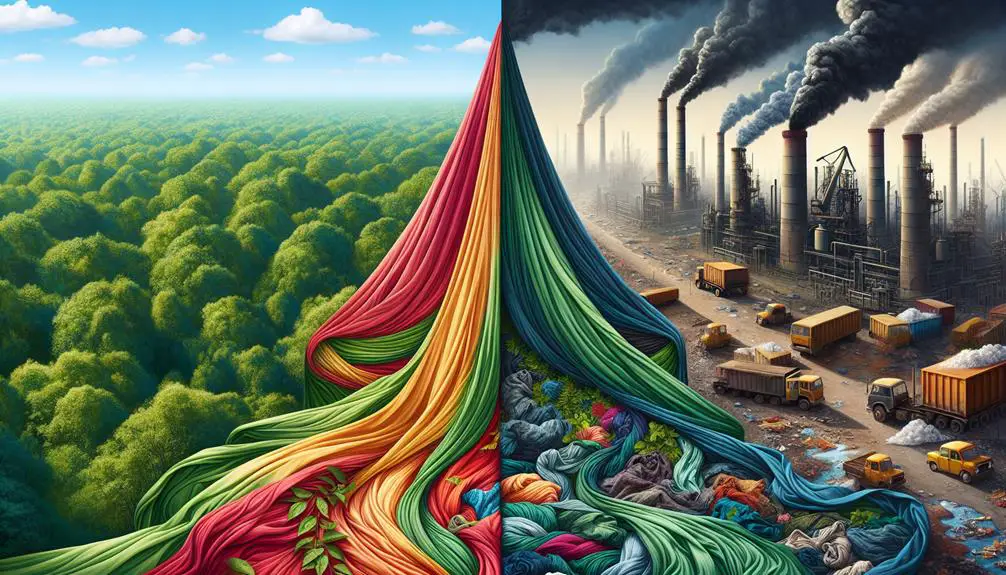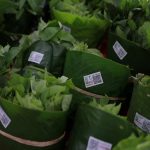So, I've been thinking a lot about rayon lately. It's one of those materials that feels fantastic, right? Soft, drapes wonderfully, and it's not too shabby at keeping its color and shape. But, and there's always a but, it's not all sunshine and rainbows. The fabric's a bit of a diva when it comes to care—shrinkage, reduced strength when wet, and let's not even start on the environmental impact. Still, its versatility and luxe look keep it in the fashion game. Makes you wonder, is rayon really worth the hassle? Stick around, and let's unpack this together.
Table of Contents
Key Takeaways
- Rayon has a soft, luxurious feel and drapes well, making it versatile in fashion.
- It absorbs moisture excellently, retaining shape and color well.
- The fabric shrinks quickly, is less durable when wet, and requires delicate care.
- Production involves chemical processes, contributing to environmental concerns and pollution.
- Rayon's lack of sustainability includes high water consumption and impact on deforestation.
What Is Rayon?
Rayon's a semi-synthetic fabric that's made from cellulose fibers and is both soft and luxurious. I've always been intrigued by how something so cozy and upscale feeling can come from nature yet still requires human ingenuity to become the fabric we love. Rayon, or viscose as it's sometimes called, holds a unique spot in my wardrobe for exactly those reasons.
Digging into what makes rayon so special, it's all about those cellulose fibers. They're derived from wood pulp, making rayon a fascinating bridge between natural and synthetic textiles. The process of transforming this wood pulp into the soft, drapable fabric we know involves some pretty complex chemistry, but the end result is a material that's incredibly versatile.
I've noticed that rayon's popularity in the fashion industry isn't just about its touch or its sheen. Its ability to absorb moisture and stay cool makes it a go-to for warmer months. However, I'm always cautious about where and how I wear my rayon pieces, considering its unique properties.
Benefits of Rayon
Considering its versatility, I've found that one of the biggest benefits of rayon is its soft and luxurious feel, making it a favorite in my wardrobe for both comfort and style. The way this versatile fabric drapes and falls just right, it's easy to see why it's a staple in the fashion industry. Not only does it offer a high-end appearance, but it's also incredibly comfortable to wear, especially in warm weather, thanks to its excellent moisture absorption.
Another thing I love about rayon is that it's practically wrinkle-free and retains its shape and color beautifully over time. This makes it a go-to for those days when I need to look my best without the hassle of ironing. Plus, with the introduction of EcoVero, a more sustainable version of traditional rayon, I feel better about the environmental impact of my fashion choices. It's a relief to know that my preference for soft, comfortable, and versatile fabrics can also align with a more sustainable lifestyle.
Disadvantages of Rayon
While I've highlighted the many benefits of rayon, it's also important to be aware of its downsides. Let's dive into the key drawbacks that might make you think twice about this fabric.
| Disadvantage | Description | Impact on Use |
|---|---|---|
| Shrinks Quickly | Rayon can lose its shape and size easily in water | Requires delicate washing care |
| Less Durable | Becomes weaker when wet, prone to damage | Not ideal for heavy use items |
| No Stretch | Lacks flexibility compared to some fabrics | Limits design and fit options |
| Not Sustainable | Production harmful to the environment | Concerns for eco-conscious users |
First off, rayon's tendency to shrink quickly means you've gotta be extra careful when washing it. This fabric demands a lot of delicate care, which can be a hassle if you're always on the go. Plus, it's less durable, especially when it gets wet, making it a less reliable choice for anything that might see a lot of wear and tear. The lack of stretch can also be a bummer, limiting how and where you can use it. Finally, its environmental impact can't be ignored; it's simply not sustainable, though EcoVero offers a greener alternative.
Rayon Fabric Care Tips
To keep your rayon clothes looking their best, it's crucial to follow a few simple care tips. I've learned the hard way that cutting corners just doesn't do justice to this delicate fabric. Here's the lowdown to help you master rayon fabric care, ensuring your garments stay fresh and in great shape.
- Cold Water Wash: Always stick to cold water when washing rayon. Hot water is a big no-no as it can cause the fabric to shrink. I make it a point to hand wash my rayon items separately or use the delicate cycle on my washing machine.
- Avoid the Dryer: I learned early on to skip the dryer. Instead, I opt for hanging dry my rayon pieces. This method helps preserve the fabric's quality and prevents any unwanted shrinkage. Plus, it's a great way to save on energy costs.
- Iron with Care: Ironing rayon isn't as daunting as it sounds. I turn my garments inside out and set my iron to the lowest heat setting. It's a surefire way to avoid damage and keep everything looking crisp.
Rayon in Fashion
Rayon's versatility in fashion is undeniable, as it's become a staple for both high-end and casual designs. This semi-synthetic fiber has truly made its mark in the fashion industry, offering designers a soft and comfortable material that works for a wide range of garments. From flowy tunics and elegant dresses to breezy shirts, rayon fabrics bring a touch of luxury without breaking the bank. It's this unique combination of affordability and high-end appearance that has solidified its place in wardrobes across the globe.
What I find remarkable is how rayon blends seamlessly with other materials like cotton and polyester, opening up endless styling possibilities. Whether it's a scarf that adds just the right amount of flair to an outfit or a tie that stands out with its distinct texture, rayon accessories have a way of making a statement. And let's not forget the comfort factor. Clothing made from rayon not only looks good but feels heavenly against the skin, thanks to its soft, drapey nature.
For anyone passionate about fashion, understanding the importance of proper storage is key. Keeping rayon garments in a cool, dry place ensures they remain pristine, ready to make a style statement whenever you are.
Printing on Rayon
One of the biggest perks of rayon is its ability to hold onto vibrant colors, making it perfect for all sorts of detailed printing designs. When it comes to printing on rayon, I've found it's a game-changer for creating unique clothing creations that stand out. The fabric's printing capabilities are just top-notch, offering endless possibilities to play around with.
Here's what's super cool about printing on rayon:
- Custom Printing Services: Places like House of U are a godsend, offering custom printing on Rayon Paris and Rayon Voile. It means you can literally bring any design to life.
- Vibrant and Lasting Colors: Rayon doesn't just accept ink; it embraces it, ensuring your designs pop and stay vibrant wash after wash.
- Expert Advice Available: Not sure which rayon fabric to choose for your masterpiece? No worries! Expert advice on selecting the right fabric for your specific printing designs is just a conversation away.
The bottom line? Rayon's printing capabilities transform ordinary garments into unique masterpieces, making it a favorite for anyone keen on customizing their wardrobe.
Rayon Sustainability
Despite its popularity, rayon's environmental footprint raises serious concerns. The fabric, while silky and versatile, comes with a hefty ecological price tag. It's not just about the feel-good texture; we're talking about a chemical-intensive production process that doesn't do Mother Nature any favors. I've learned that creating rayon isn't a walk in the park. It guzzles water like there's no tomorrow, and the pollution it spews into our air and water sources is nothing short of alarming.
Now, consider this: over 150 million trees are chopped down annually to keep up with the demand for viscose rayon. That's a lot of forests on the chopping block, many of which are endangered. It's a deforestation disaster, and it's happening on our watch. The aftermath of rayon production isn't pretty either. Those chemicals used to turn wood pulp into soft fabric? They don't just disappear. Disposal is a problem, polluting our planet even further.
I've heard whispers of a more sustainable option, EcoVero, touted as the greener sibling of traditional rayon. It's a step in the right direction, aiming to lessen the environmental impact. But it's clear: the road to truly sustainable rayon is a long one.
Comparing Rayon and Cotton
Alright, let's talk about how rayon and cotton stack up, focusing on their environmental impact and how comfy and durable they are.
I've noticed cotton's a champ in hot weather because it breathes and soaks up sweat better than rayon.
But, rayon has that smooth look and feel that's hard to beat, even though it mightn't last as long as cotton in your wardrobe.
Environmental Impact Differences
When comparing the environmental impacts of rayon and cotton, it's clear that both have their downsides. Rayon uses more chemicals and energy in its production process, while cotton requires a significant amount of water for cultivation. Let's take a closer look:
- Rayon Fabric Production: The process of turning cellulose from wood into rayon fabric is tough on the environment due to the use of chemicals and a high energy demand. This not only impacts the environment but also raises concerns about the sustainability of the trees involved.
- Cotton Cultivation: Cotton is known for being a thirsty crop that consumes a significant amount of water during its growth. While this heavy water usage is not ideal for the planet, cotton is biodegradable and has some sustainability advantages compared to rayon.
- Environmental Impact: Both rayon and cotton have their environmental issues. Rayon contributes to deforestation due to its reliance on wood-derived cellulose, while cotton's water-intensive cultivation practices pose challenges for water resources. Choosing between these two materials involves considering the trade-offs between deforestation and water usage.
Comfort and Durability
Diving into comfort and durability, rayon's got that super soft touch, but cotton brings the toughness to last.
Here's the lowdown: rayon fabric is highly comfortable, no doubt. It's soft, has a luxurious feel, and drapes like a dream. But when it comes to lasting power, it kinda falls short. Rayon shrinks faster than you can say 'laundry day' and doesn't play well with water, getting weaker when wet.
Cotton, though? It's the heavyweight champ of durability. More stretchable, it moves with you and can take a beating in the wash without losing its cool. Plus, cotton's breathability is top-notch, keeping you comfy no matter the weather.
Future of Rayon
Looking ahead, the future of rayon seems bright with its market value expected to hit $28 billion by 2025. This isn't just a random number; it's a testament to how much this versatile fabric has woven itself into the fabric of our lives. Here's why I think we're going to see even more of rayon:
- Its ability to mimic luxurious natural fibers like silk and cotton, without the hefty price tag, makes it a go-to for budget-conscious fashionistas and designers alike.
- The textile industry's continuous innovation means rayon's lustrous finish and durability are only getting better, making it a staple in both high fashion and everyday wear.
- Sustainability efforts are pushing for more eco-friendly production methods, which could make rayon an even more attractive option for those looking to reduce their environmental footprint.
Rayon's been around since the late 1800s, but its relevance hasn't waned. Its blend of affordability, versatility, and that sought-after lustrous finish keeps it at the forefront of the textile industry. So, I'd say the future of rayon looks not just bright but downright dazzling.
Frequently Asked Questions
What Are the Disadvantages of Rayon?
I've found rayon's disadvantages include its quick shrinking, weakening when wet, lack of stretchability, and sustainability concerns due to chemical-heavy production and sourcing from endangered forests. EcoVero's a better alternative for eco-conscious choices.
Is Rayon a Good Quality Fabric?
I think rayon's a good quality fabric because it's soft, comfortable, and looks luxurious. It's absorbent and drapes nicely, making it a hit in fashion. Despite its downsides like shrinkage, it's still a solid choice.
Does Rayon Shrink Every Time You Wash It?
Yes, I've found that rayon does tend to shrink every time it's washed, especially if I don't follow the care instructions to a T. Washing it in cold water and air drying helps a lot.
Can You Put Rayon in the Dryer?
I wouldn't recommend putting rayon in the dryer because it's prone to shrinking and heat damage. Air drying or using low heat is safer to keep your clothes in good shape. Better safe than sorry!
- Tetron Fabric Price in the Philippines: A Detailed Look - June 17, 2025
- Tetron Fabric Price Guide: What to Expect - June 17, 2025
- Where to Buy Tetron Fabric: Top Retailers and Online Stores - June 17, 2025





